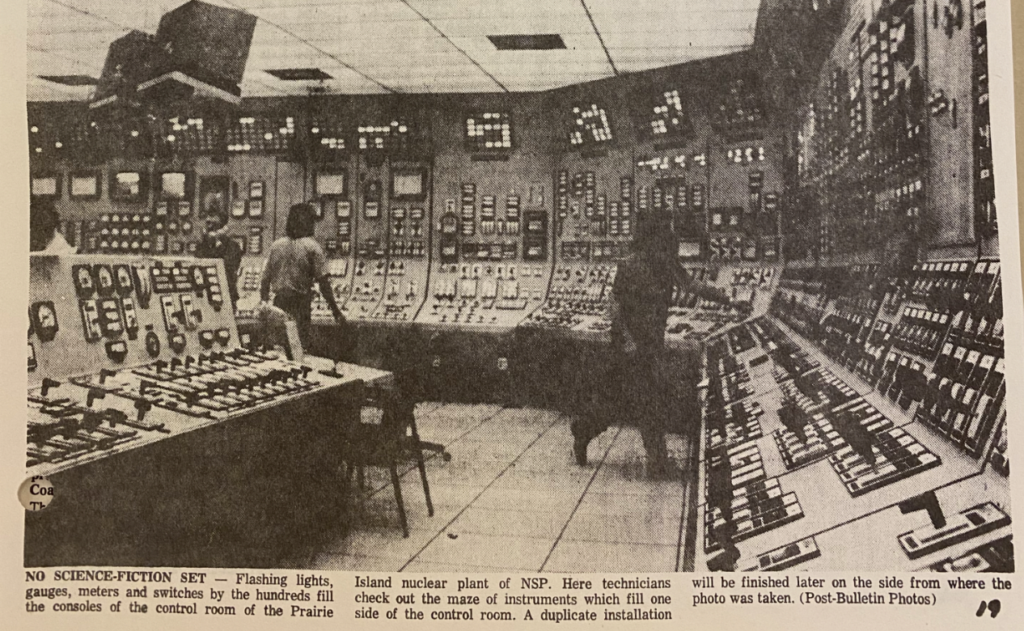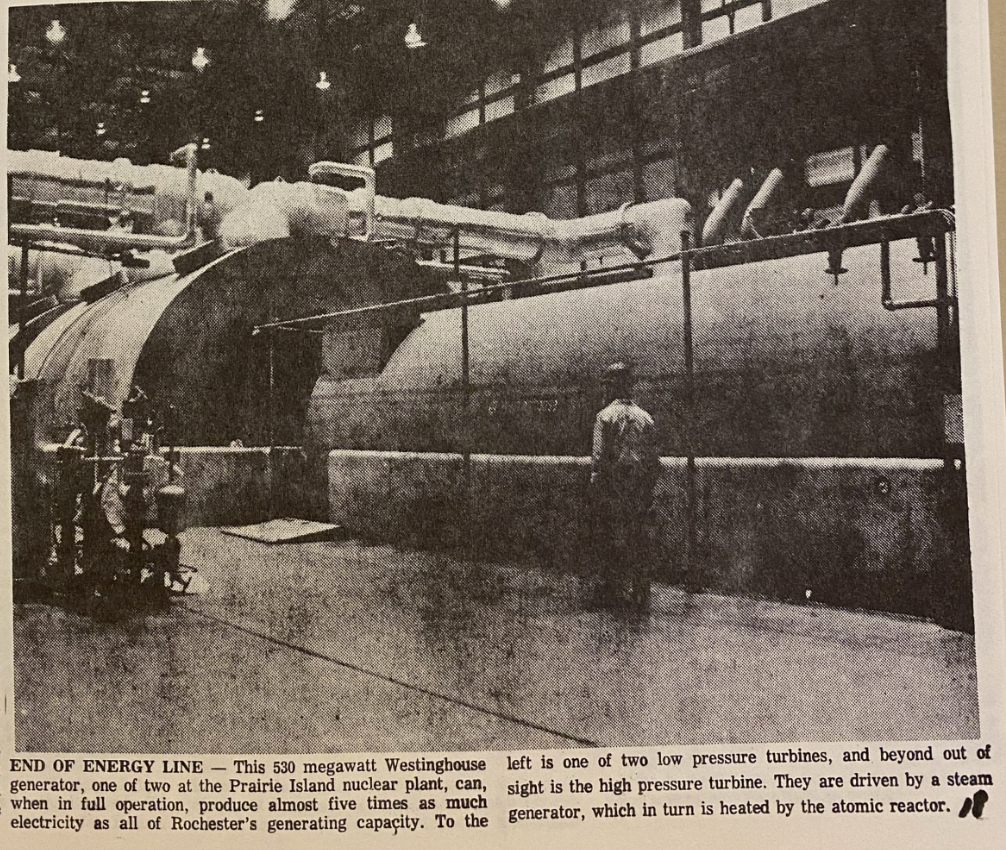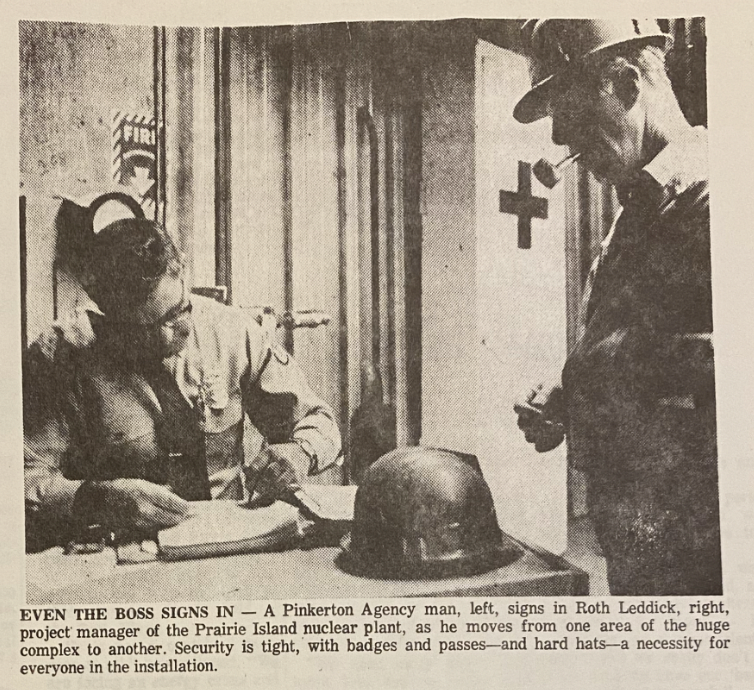Media Reactions

Media Findings
In mainstream media from 1970 to 1974, it was mainly local newspapers that were writing about the Prairie Island Nuclear Plant. We found sixteen mentions overall. There are likely more articles that exist, but our research time was limited and the archive collection was somewhat fragmented with unclear record-keeping.
- Minneapolis Tribune (1970 and 1973)
- Saint Paul Dispatch (1970 and 1974)
- Eau Claire Leader-Telegram (1973)
- Saint Paul Pioneer Press (1973)
- Red Wing Republican Eagle (1973 and 1974)
- Glenwood Tribune (1974)
- Rochester Post-Bulletin (1974)
Topics Addressed
The majority of the articles focused on the opening of the first reactor in 1973 followed, ironically, by a nine-week shutdown. The plant was authorized to run at ninety percent capacity on December 4, 1973 and had broken two turbine blades by December 17 after only reaching fifty percent capacity.

The plant remained shut down until early February despite promises to have it running in January.
An NSP official quoted in the Red Wing Republican Eagle said he would “rather not guess” when plant would be running at ninety percent capacity. There was constant focus on the need for the plant to be up and running in order to “avoid burning some 31.2 million gallons of fuel oil this winter.” Many articles highlighted this sense of urgency. At this time, a general theme of concern over nuclear waste storage was growing in more widely-known publications.

Conflicting Research
In 1973 activists were calling for a worldwide moratorium on construction of nuclear plants, but media reaction and support seemed to vary. The Eau Claire Leader-Telegram quoted University of Minnesota professor Dr. Dean Abrahamson saying, “reactors should be last choice of a desperate nation.” On the other hand, the Glenwood Tribune attacked the Pollution Control Agency for their pushback on the plants, claiming they were furthering pollution by fighting clean nuclear energy solutions with no real research to support their fears.
“Nuclear-powered plants are capable of providing this nation with low-cost power indefinitely, and until someone proves that their emissions are dangerous to the public health, let’s get on with the job.”
—Glenwood Tribune, 4/23/1973
Perhaps most significantly, in December 1973, the Saint Paul Pioneer Press detailed the 1972 hearings that determined whether the plant would be licensed. In these hearings, an NSP-testifying physician claimed that “exposure to plant-produced radiation would result in only one additional case of cancer over the next 500 years.” However, a physicist testifying for the Pollution Control Agency argued that there could be “as many as 192 cancer deaths and serious genetic defects over a 40 year period.”

Interestingly, this physicist later “modified his testimony down to 1.7 deaths and genetic defects over that same amount of time.” The newspaper provided no explanation for this drastic change in opinion. The plant was given a license at the end of the hearings despite PCA’s protests.
Effect of the Media
Overall, while local newspapers appeared transparent, they largely stuck to the same limited set of facts. In all the articles, we found only two references to the technical functioning of the plant. While today we have access to official NSP documents, the information readily available to the public at the time was vague and minimal. Most articles emphasized safety and reassurance from NSP representatives. These findings connect to the compartmentalization of knowledge often seen in discussion of nuclear energy. Certain topics seem to have been deemed too complicated or alarming for the general public.
“’There is no way an error in operation could cause the reactor to go out of control.’”
—Prairie Island Nuclear Plant Project Manager, Rochester Post-Bulletin
Interestingly, the articles that provided more details often conflicted in how they framed the plant. A Rochester Post-Bulletin article called the plant “bewildering,” “a science fiction movie set,” and “maze-like,” while at the same time emphasizing the unassuming outside appearance and “conventional” functionality.
“From the distant Goodhue County road, it won’t even look spectacular.”
-Rochester Post-Bulletin
Newspapers seemed to be unsure of how best to present the plant to the public. The Rochester Post-Bulletin took a contradictory approach of both sublime and mundanity while many others abandoned direction entirely, causing the information they provided to be incomplete and unhelpful.
